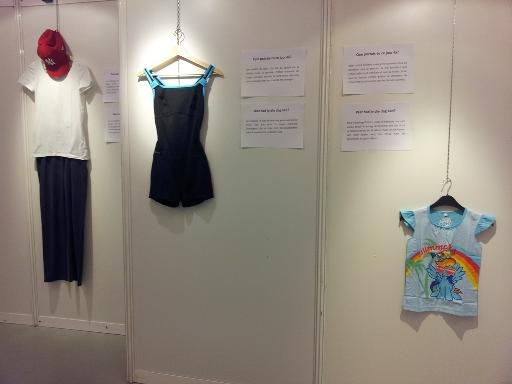The Prevention Service of the commune Molenbeek-Saint-Jean in partnership with the University of Kansas, from this Monday has opened the exhibition entitled “What were you wearing on that day?”. This is a question all too often asked of victims of sexual assault. This is the first time the exhibition has taken place in Europe. It is being held from January 8th to 20th in the Centre Communautaire Maritime in Molenbeek-Saint-Jean. Françoise Schepmans (MR), the Mayor of Molenbeek says, “Its objective is to encourage victims of sexual assault to ‘speak out'. It is also to highlight that nobody is immune, regardless of the location of a given incident or what they are wearing.”
The exhibition proposes a simple, highly visual and efficient mechanism. Eighteen outfits that female students from the University of Kansas wore when sexually assulted are on display for the public. A pair of jeans, a T-shirt, pyjamas and black trousers - all ordinary clothes. These serve to dismantle the myth of victim responsibility, and the underlying idea that the assault would not have happened if the victim had worn provocative clothing which was less provocative. Next to these clothes, the victims evidence in a few sentences the rape which they have suffered and what they were wearing that day.
The exhibition clearly evidences that a sexual assault never occurs owing to what an individual is wearing, but because one individual intends to attack another. The items of clothing on display are everyday and basic. They remind visitors that no item of clothing can actually protect women from sexual assault or provokes it. The manager of the Prevention Service Projects in the commune of Molenbeek-Saint-Jean, Delphine Goossens, says, "that the direct nature of the question “What were you wearing that day?” asked of victims of this type of attack makes them responsible for what they have suffered and weakens the attacker’s responsibility.”
“What were you wearing on that day?”, intends to attack the rape culture and through de-constructing stereotypes, has been shown several times on American campuses. Showing the exhibition in Belgium is a European first and the Molenbeek Prevention Service mentions several figures, which entirely confirm its relevance. A Survey produced by the European Commission in 2014, showed that 1 in 5 Belgians consider that rape is justified when “under the influence of drink or drugs”. In addition, some 16% of Belgians consider that the given rape is not an issue if the victim is dressed provocatively. Moreover, some 46% of Belgians, both woman and men, either are or will be victims of sexual violence considered to be “serious” during their lifetime.
For Sarah Turine (Ecolo) Alderwoman with responsibility for Prevention Policies and Social Cohesion in the commune of Molenbeek-Saint-Jean, the exhibition falls within the current media spotlight on such issues. This is particularly so with the revelations of sexual assault, as part of the Weinstein affair. It serves to reminds us of the “action that must be taken in this sphere as to the awareness-raising on the issue, as well as gender equality and individual dignity.”
The Brussels Times

